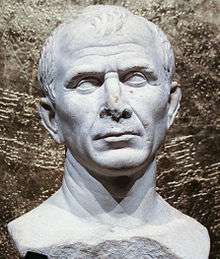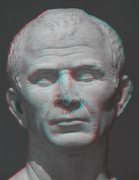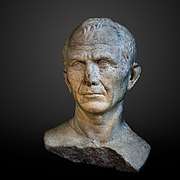Arles bust
The Arles bust is a life-sized marble bust showing a man with nasolabial creases and hollows in his face. It was discovered in September–October 2007 in the Rhone River near Arles, southern France, by divers from the French Department of Subaquatic Archaeological Research.[1] During the same campaign, divers also recovered smaller statues of Marsyas in Hellenistic style and a life-size marble sculpture of Neptune dating, from its style, to the 3rd century AD.

It has been debated that it is a possible portrait of Julius Caesar.[2]
Analysis
The uncompromising realism of the portrait places it in the tradition of late Republican Roman portrait and genre sculptures of the 1st century BC. The archaeologists suggested that this was a portrait of Julius Caesar and that it should be given a date of about 46 BC, making it, according to France's Minister of Culture Christine Albanel, the oldest known representation of Caesar.[3] They further suggested that the bust was discreetly disposed of after Caesar's assassination in 44 BC, when portraits of him could have been politically dangerous possessions.[4]
The story was carried by many major media outlets.[5][6] However, classicist Mary Beard objected that there was no basis whatsoever for identifying it as Caesar, and accused the discoverers of staging a publicity stunt.[7] Other historians were also quick to dispute the identification, among them Paul Zanker, an archaeologist and expert on Caesar and Augustus.[8] Many noted the lack of resemblances to Caesar's likenesses issued on coins during the last years of the dictator's life, and to the "Tusculum bust" of Caesar,[9] which is accepted as a depiction of Julius Caesar from his lifetime, based on its similarity to the coin portraits.
After a further stylistic assessment Zanker dated the Arles bust to the Augustan period. Elkins pointed out the 3rd century AD as the outside terminus post quem for the deposition of the statues, thereby disputing the claim that the bust was thrown away due to feared repercussions from Caesar's assassination in 44 BC.
Controversy about the identity of the bust is ongoing among French archeologists.[10]
 3D anaglyph of the marble bust found in the Rhone River near Arles
3D anaglyph of the marble bust found in the Rhone River near Arles


Notes
- French: Département des recherches archéologiques subaquatiques et sous-marines (Drassm)
- "Bust from riverbed reveals face of Julius Caesar"
- Original communique (May 13, 2008); second communique (May 20, 2008); report (May 20, 2008)
- "I suspect the bust was thrown in the river after he was assassinated because it would not have been good at that time to be considered a follower of his," said French archaeologist Luc Long, quoted by Agence France Presse at the time the discovery was revealed (Bust from riverbed reveals face of Julius Caesar: archeologist; France24: "Un buste de Jules César découvert à Arles", 14 May 2008 Archived 12 August 2009 at the Wayback Machine).
- "Divers find marble bust of Caesar that may date to 46 B.C.", CNN-Online et al.
- Video (QuickTime) Archived May 28, 2008, at the Wayback Machine on the archaeological find (France 3)
- "Mary Beard, "The face of Julius Caesar? Come off it!", TLS 14 May 2008, on-line". Archived from the original on 21 March 2009. Retrieved 29 May 2008.
- Paul Zanker, "Der Echte war energischer, distanzierter, ironischer" Archived May 29, 2008, at the Wayback Machine, Sueddeutsche Zeitung, May 25, 2008, on-line; Nathan T. Elkins, 'Oldest Bust' of Julius Caesar found in France?, May 14, 2008, on-line
- the "Tusculan bust": image at the AERIA library.
- "Quid de Cesar?", France 2 10 July 2010, on-line
External links
| Wikimedia Commons has media related to Presumed bust of Caesar-RHO.2007.05.1939. |